Competitive Content Analysis: Your Step-by-Step Guide
Topic: SEO
Published:
Written by: Bernard Huang
In marketing, it’s easy to get frustrated with the competition. It might even be tempting to wish that you didn’t have any.
But competition may be one of the best resources you have to inform strategies like content marketing. And it pushes the envelope for you to do better by your target customer. Without competition, there is mediocrity.
Walt Disney once said, “I have been up against tough competition my entire life. I wouldn’t know how to get along without it.”
Top performers don’t just accept their competition. They know how to use the competition to better themselves.
In this article, we’ll talk about competitive content analysis, go over what makes it such an effective strategy, and walk you through the process step by step.
What is a competitive content analysis?
Competitive content analysis is the process of identifying your competitors and analyzing their content strategies to determine what tactics work well and benchmark your own performance. You can also uncover a competitor’s weaker points and figure out where you have relative strengths.
Why should you analyze your competitors’ content?
Taking the time to analyze competitor content helps you keep your search engine optimization (SEO) content strategy up to date and competitive.
How?
First, it lets you understand your competitive baseline and know where you stand in the industry. And second, it helps you identify opportunities like content gaps and areas where you can improve your content.
Analyzing successful competitors also gives you a roadmap for success. As content marketers and SEOs, figuring out what works can be confusing. Instead of finding success through trial and error, you can learn much faster by seeing what works for your competition — or what doesn’t.
That said, a complete competitive content analysis requires a decent amount of manual qualitative work. You should aim to do it at least once a year to stay current.
How to do a competitor content analysis in 6 steps
Identify your competitors.
SEO competitive analysis.
Audit your competitors’ content.
Evaluate content quality.
Note their SEO metrics and strategy.
Research their content distribution.
As you audit your competitors’ content strategies, here are a few useful questions to keep in mind:
Are there opportunities my competitors miss that I can take advantage of?
What do I like and dislike for my brand?
How can I improve upon what my competition is doing?
1. Identify your competitors
The first step of analysis is to create a list of competitors, including direct and indirect.
Direct competitors include brands and businesses that offer the same products/services to a similar target audience as you.
Indirect competitors include those who offer similar products or solve the same customer problem in a different way.

Types of competitors: Direct vs. indirect.
You can also include industry influencers in your list. They may not sell the same products, but they educate your target audience on similar topics.
For instance, WordPress is a content management system (CMS) that lets people create websites without needing technical expertise. Its direct competition includes other CMS platforms like Wix and Squarespace.
Its indirect competition includes agencies and web designers that solve the same problem (needing a website) by creating and managing it for their clients.
WordPress’s blog may also compete with influencers like CodeinWP that publish articles about website building, even if they don’t sell a competing product.
Tip: If you use SEO content editors like Clearscope, you can identify the top competitors for your target keyword. These are the currently top-ranked pieces in the search engine results pages (SERPs).
2. SEO competitive analysis
Use SEO tools such as Semrush and Ahrefs to investigate your direct and indirect competitors SEO strategy.
Keyword research
Identify keyword opportunities and new keywords by peeking at what your competitors are ranking for. Make note of specific keywords that align with your business and product(s).
Backlink profile and strategy
Dig into your competitors' backlinks to see which websites are linking to them. Make note of trustworthy websites (at the referring domain level) and which pages receive the most backlinks excluding the homepage.
Use this insight to support your link building strategy.
3. Audit your competitors’ content
This part is where the hard work happens. It’s time to take a deep dive into your competitors’ on-site content. It takes a few steps.
Key content categories
Look at your competitors' sites menus, navigation tools, or blog tags to identify their broader content strategy. What main topics do they cover, and how do they divide them into subtopics?
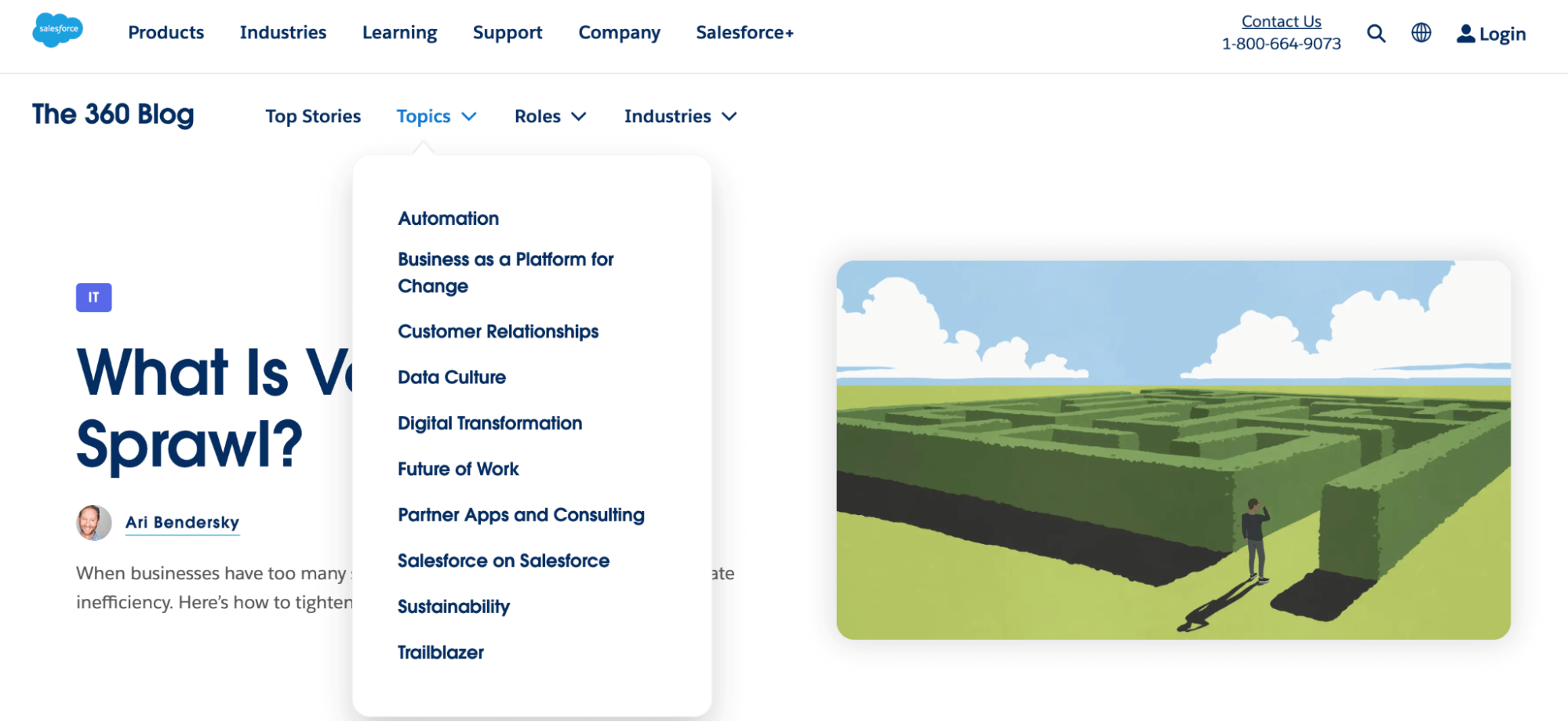
Salesforce blog page with topics dropdown menu (image source).
Asset types
Make a list of the types of content they create and note the quantity of each one.
Examples of asset types include blog posts, webinars, videos, infographics, white papers, and case studies.
If your competitor primarily has a blog (and no other assets), you can tally up/categorize their blog posts by format. Blog content formats include how-to guides, company or product updates, industry updates, and interviews.
You can also note whether their content is free to access or gated. If both, what’s the percent mix?
Content’s purpose
Take note of the content’s main goal. Are they using the piece to drive conversions? Or is it positioned to attract backlinks?
Publishing frequency
Do your best to figure out how often your competitors post. See who’s publishing a couple of times per month compared to multiple times a week. Note whether your competitors follow a consistent schedule.
If your competitors don’t include a publish date, this information may be harder to find. You could watch their content over time to get a general idea of how frequently they publish.
Contributors
Finally, look at who is writing their content. Understanding who contributes to your competitors’ blogs gives you insight into tactics they use to add credibility to their brands.
Do they name authors?
Do they feature guest posts?
Do they feature other brands?
From what you can tell, how many contributors does the blog have?
For instance, a competitor may include the names and credentials of expert contributors, which gives readers more reasons to trust the content and the brand.
4. Evaluate content quality
After you’ve defined the broader strokes of your competitors’ strategies, it’s time to dig deeper into their content quality. To do so, you can rate your competitors’ content quality on several dimensions.
This is helpful for understanding the quality expectations of the industry. With benchmarks, you can figure out where you stand in the industry and identify opportunities to set your brand apart.
Here are a few categories to rate and analyze their quality.
Content length
What’s the average length of your competitors’ blog posts or videos?
How in-depth do they go when covering topics?

Clearscope’s competitor tab for the keyword “best email marketing services.”
Tip: When creating a new piece of content, use Clearscope’s content analysis tool to identify areas prime for content optimization tool to see a recommended word count based on the keyword. You can also look at the competitor tab to see the content length and quality of each competitor.
Accuracy
Is their information accurate?
Do they cite sources when stating facts?
Do they support claims with statistics and other quantitative data?
Tip: When creating a new piece of content, you can use Clearscope’s Research tab to find commonly cited sources.
Uniqueness
Does your competitor include tactics that make their content unique, such as first-hand research, expert quotes, or custom graphics?
Imagery
Does the competition include imagery?
What kind of visuals do they include?
Graphs/data visualizations
Annotated screenshots
Featured quotes
Stock images
Infographics
GIFs
At this stage, you can note what they include and what you like/don’t like for your brand.
Readability
Make a note if competitor posts tend to include grammar or spelling errors. Beyond that, you want to assess the post structure and complexity of the writing.
Analyze for the following:
Do they use headers?
Do they use tables of contents?
Are the articles visually easy to read and skim to find information?
What is the difficulty level of their writing? Is it appropriate for your target audience?
(You can use tools like Clearscope, Hemingway Editor, or Readable to get the reading level of a piece.)
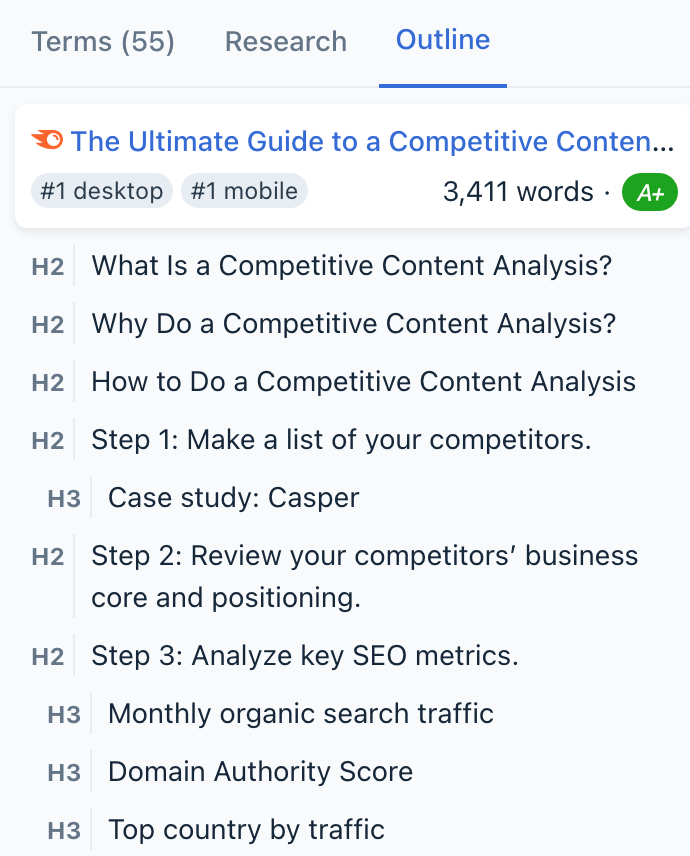
Clearscope outline feature for the keyword “best email marketing services.”
Tip: When writing new content pieces, you can use Clearscope’s Outline tab in the editor to extract headings from the top-ranked pieces for your target keyword.
Tone
Tone refers to how a writer addresses the reader and talks about the subject. It can create a personality for brands.
Here’s what to look for in your competitor’s writing:
Do they use humor? If so, how?
How would you describe their tone?
Casual vs. formal
Friendly vs. professional
Respectful vs. irreverent
Do they write in first, second, or third person?
How would you describe the tone and voice of their calls to action (CTAs)?
5. Note their SEO metrics and strategy
Finally, you want to look at SEO performance and strategy.
Analyze key SEO metrics
You can use an SEO competitor analysis tools like Semrush or Ahrefs to get an overview of your competitors’ core SEO metrics, such as:
Backlinks
Core Web Vitals
Domain authority
Average time on site
Number of top ten keywords
Monthly organic search traffic
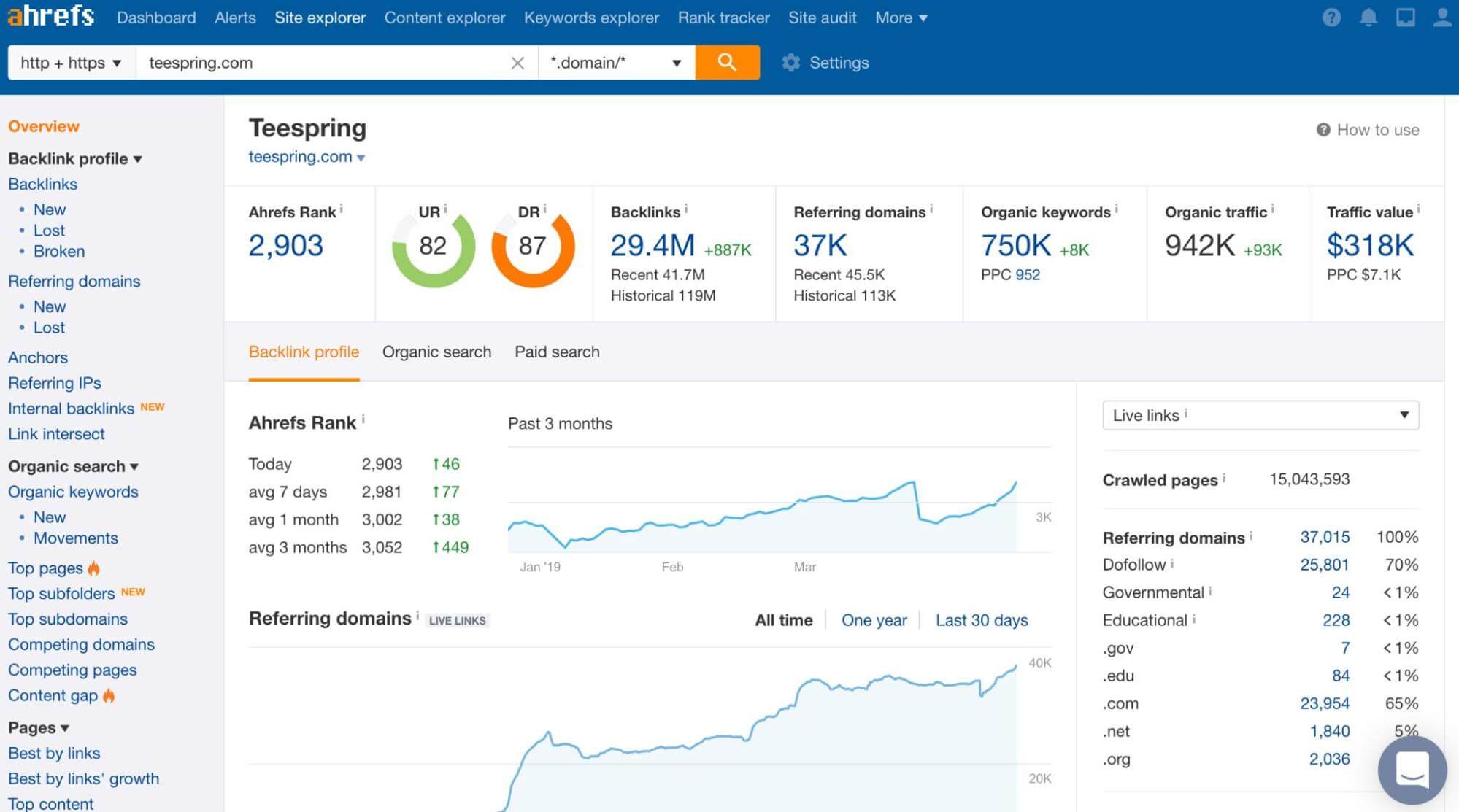
Ahrefs Site Explorer results for teespring.com (image source).
Note which competitors perform the best in given metrics. This will give you some benchmarks to aim for in your own performance.
You can search your competitors’ websites on Google’s Page Speed Insights tool to see their performance on Core Web Vitals. The Core Web Vitals report shows the big-picture strengths or weaknesses of a domain’s technical SEO by measuring the website’s user experience based on real-world data.
Knowing how your competitors perform gives you a performance baseline to try to meet or exceed.
Look at competitors’ SEO strategies
How well does each competitor optimize for search? In this step, you want to look qualitatively at their on-site content for SEO signals.
In particular, you can assess the following:
Are they using the primary keyword in these areas?
Meta descriptions
Image alt text
Page title
URL slug
Meta title
H1 tags
What semantic keywords are they including?
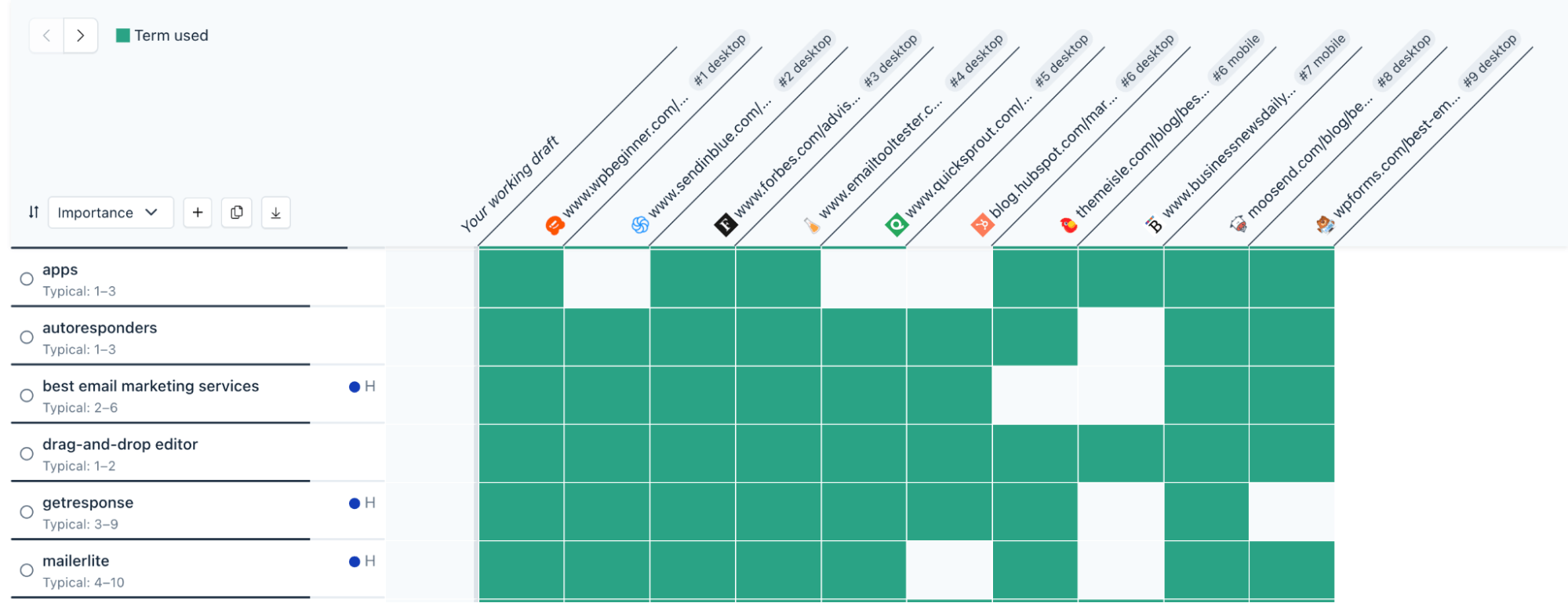
Clearscope Term Map for the keyword “best email marketing services.”
Tip: When creating a new piece of content, you can see which competitors use certain semantic keywords in Clearscope’s Term Map tab.
6. Research their content distribution
Distribution is an essential part of any content marketing strategy, even if your goal is to focus mainly on driving organic traffic. When you’re doing a competitive content analysis, it’s important to see how well other brands leverage social media and internal links to improve the discoverability of their posts.
Social media
While SEO content aims to generate website traffic from search engines, sharing content on social media can help with visibility, distribution, and brand awareness.
Look at your competitors to see how they use different social platforms to share content, including:
Facebook
Pinterest
YouTube
Linkedin
Twitter
When looking at social platforms, it’s helpful to consider all of them, but you may want to focus more on their strategy for platforms that are most relevant to your brand.
If your competition isn’t on social media, there’s a gap and an opportunity for you to create a unique competitive advantage.
Internal linking strategy
Internal linking is another useful strategy to increase user engagement on your website and encourage readers to access more of your content.
Note whether your competitors are using this strategy by checking:
Are they including internal links?
How often do they include links?
What pages are they linking to? Other content? Product pages?
Do competitors use banner ads or non-text CTAs in their content?
How to apply competitor insights to your content strategy
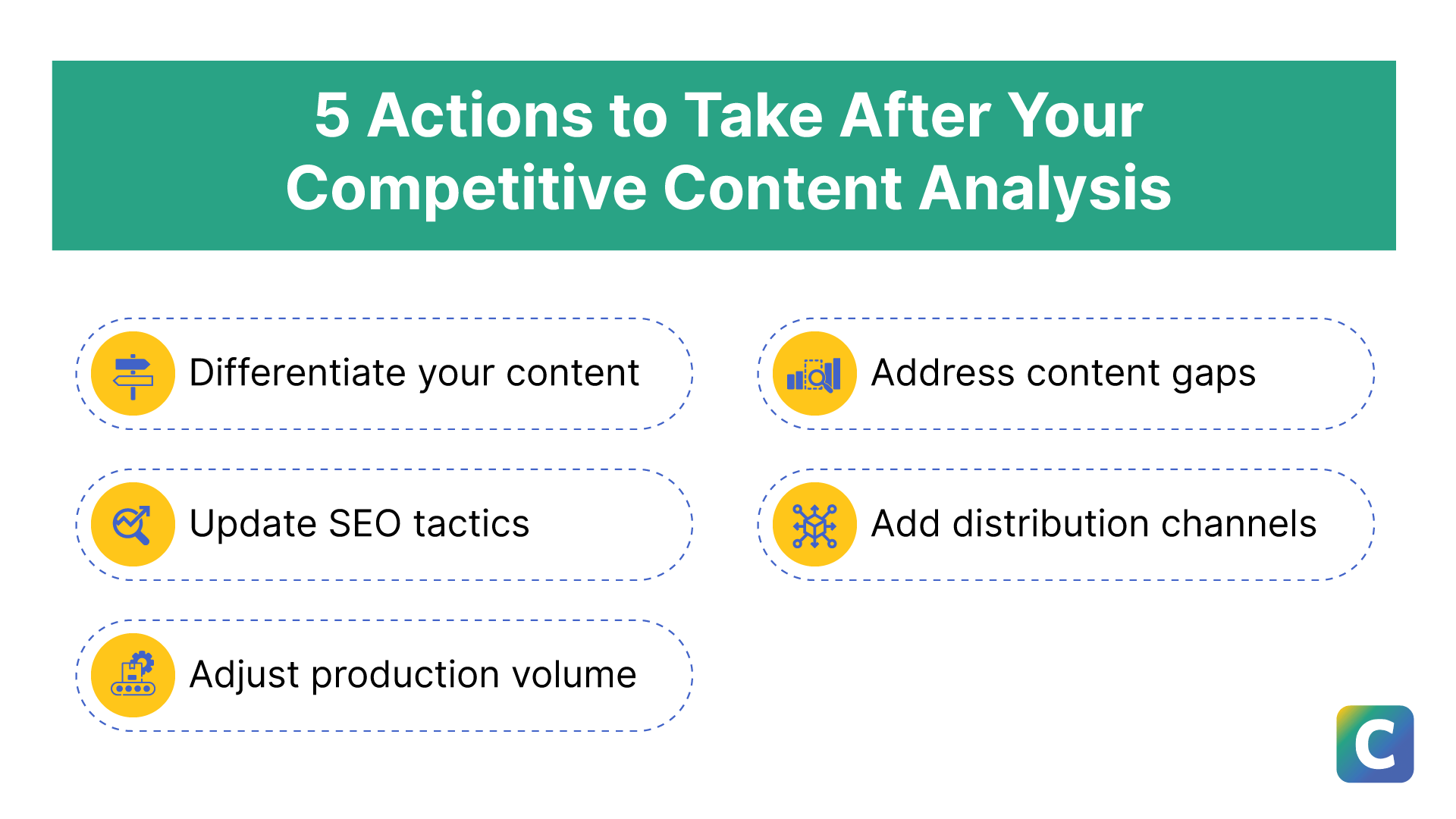
Five ways to incorporate competitive analysis insights into your content marketing strategy.
Now that you’ve analyzed your competitors, it’s time to update your content and digital marketing strategy.
Differentiate your content quality
Differentiation may seem like an obvious element of your brand strategy, but it’s easier said than done. The CMI report found that 83% of B2B content marketers say they differentiate their content from competitors by creating higher-quality content.
The good news is that your competitive content analysis insights can help you differentiate your brand and identify opportunities to improve upon what’s already out there.
One of the best ways to set your brand apart is by producing higher-quality content.
You can improve your content quality and make it more unique by:
Quoting technical experts
Conducting first-hand research
Interviewing industry influencers and leaders
Surveying your customers and including insights
You can also differentiate the user experience by focusing on clear structures, adding graphics that improve comprehension, and experimenting with different tones of voice. These changes are subtle but effective when applied to your entire blog.
Fill content gaps
Another way to act on competitor analysis and competitive research we performed above is to get your next content ideas from competitor data.
Quick disclaimer, don’t just write about a competitor keyword because they wrote about it. Ensure the topic and search intent align with your business and your goals.
You can cover more topics, focusing on areas that your competition doesn’t. This is a strategy used by 72% of B2B content marketers, according to the CMI report.
Another 38% of marketers differentiate by publishing in formats that their competitors don’t use. For instance, let’s say your competitors don’t publish infographics.
You can create them for each of your blog pieces (including existing posts). If you’re one of the few brands using infographics, you have a visibility advantage in image search results. And other pieces may cite your graphics.
Update your SEO tactics
A competitive content analysis can also ensure that you keep up with SEO best practices. You want to adjust your strategy to include the tactics you see your competition using.
To do so, create an on-page SEO checklist to ensure you include your primary and semantic keywords in the right places and follow other best practices to help with rankings.
Leverage the backlink analysis you completed above to steal away backlinks and deplete your competitors’ backlink profiles.
Increase distribution channels
If your competitors are using other channels, like social media and email marketing, and you’re not, that’s a gap you want to fill.
SEO content may take a few months to start generating a reliable source of traffic for your website. In the meantime, take advantage of social media to share your content.
This is an excellent place to create an advantage for your brand if you see that your competition isn’t as active on social platforms. In fact, half of the B2B content marketers in the CMI report differentiate their strategy by actively promoting content instead of waiting for search traffic to gain momentum.
Adjust production volume
If you’re publishing more or less frequently than your competition, you can experiment with your production volume.
About 30% of B2B marketers surveyed in the CMI report increased content production to differentiate from the competition. Producing more content can help with SERP visibility, but you never want to sacrifice quality for quantity.
However, if you’re trying to publish eight articles a week and your competition is only doing four, you may want to experiment with fewer pieces that are longer or more comprehensive. You may find that there’s a better way to leverage your resources.
You can also look for opportunities to recycle/repurpose content into other formats, such as videos or infographics.
Once you establish a new production schedule, do your best to stick with it, so your audience knows when to expect new content.
Final thoughts: Competitive content analysis — a step-by-step guide
Competition can feel frustrating if you don’t know how to use it to your advantage. But if you study your competition, learn from what they do well, and improve upon their weaknesses, you can create a more effective SEO content strategy.
Content Optimization Strategy: 20 Tips to Drive Leads and Traffic
Discover how to create a content optimization strategy that drives more organic traffic and generates qualified business leads for your sales funnel.
Read moreWhat are the best content optimization tools?
In need of a content optimization tool? Check out our guide of the best content optimization tools on the market.
Read moreB2B Content Marketing Strategy: Steps to a Winning Strategy
Learn how to create a B2B content marketing strategy that doesn’t just increase brand awareness, but also drives leads, revenue, and customer loyalty.
Read more